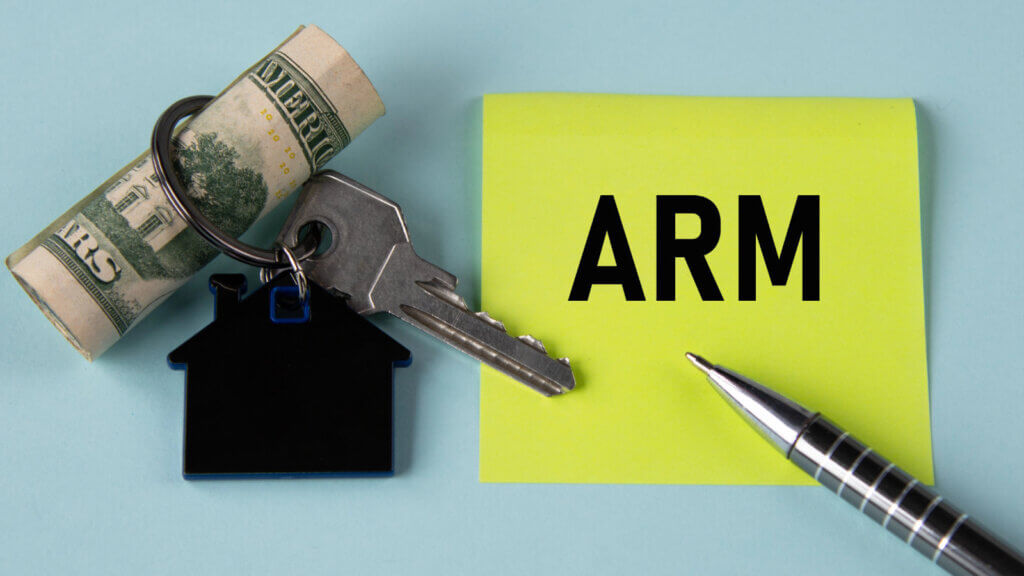If you’ve been researching home loans, you may have come across the term “ARM loan” or “adjustable rate mortgage.” Unlike a fixed rate mortgage—which keeps the same interest rate for the entire life of the loan—an ARM loan starts with a fixed interest rate for a set period and then transitions to a variable rate.
Below, we’ll break down how adjustable rate mortgages work, what their advantages and disadvantages are, and how they compare to more traditional loan types. By the end, you’ll have a solid understanding of whether an ARM loan might fit your financial goals and home-buying plans.
What Is an ARM Loan?
An ARM (adjustable rate mortgage) is a home loan that offers an initial fixed rate period at the start—often three, five, seven, or even ten years—after which the interest rate adjusts at predetermined intervals. During the fixed period, your monthly payment and rate won’t change. Once that phase ends, the interest rate can go up or down, depending on broader economic conditions and the specific terms in your mortgage contract.
Key Features
- Variable Rate Mortgage: After the introductory fixed rate period, your rate becomes variable. This means it can change periodically, usually once or twice a year.
- Index and Margin: Your new rate is typically determined by adding a margin (a set number of percentage points decided by your lender) to an index rate (like the prime rate or the secured overnight financing rate).
- Rate Caps: Most ARM loans include rate caps that limit how high—or low—your interest rate can go each adjustment period and over the life of the loan.
ARM Requirements in 2025
Qualifying for an ARM typically requires meeting stricter standards than for fixed-rate mortgages because lenders must consider your ability to make payments if rates increase substantially
| Requirement | Details | Loan Type |
|---|---|---|
| Credit Score | Minimum 620 | Conventional ARM |
| Minimum 580 | FHA ARM | |
| Debt-to-Income Ratio | Generally not exceeding 45% | Conventional ARM |
| Down Payment | Typically at least 5% | Conventional ARM |
| Loan Amount | 2025 conforming loan limit is $806,500 in most areas | Standard Markets |
| Up to $1,209,750 in high-cost markets | High-Cost Markets |
Note: Requirements may vary by lender. Contact your mortgage professional for specific details.
Current ARM Rates and Market Trends
As of March 21, 2025, the national average for a 5/1 ARM is 5.95%, down from 6.08% the previous week. By comparison, 30-year fixed-rate mortgages average 6.68%—creating a notable spread that makes ARMs attractive to some borrowers.
ARM interest rates vary by loan term:
- 3/1 ARM: 5.84%
- 5/1 ARM: 6.03%
- 7/1 ARM: 6.25%
- 10/1 ARM: 6.76%
Market data shows fluctuating interest in ARMs over time. The Mortgage Bankers Association (MBA) reported that ARM applications increased from just 3.1% of mortgage applications in January 2022 to 10.3% by May 2022 as fixed rates climbed. More recently, in 2024, ARM applications represented 7.8% of mortgage demand—the highest level for that year.
How Does an ARM Loan Work?
Understanding how adjustable rate mortgage (ARM) loans work starts with the four main components that influence your monthly mortgage payments:
Initial Interest Rate
Enjoy a fixed interest rate for a predetermined period Stable Payments
“5/1” or “7/1” ARM formats show fixed years and adjustment frequency
Index Rate
Based on market indicators like the prime rate or treasury index Market-Based
Rates typically follow Federal Reserve Bank tracked indices
Margin
Fixed percentage based on your creditworthiness Consistent Term
Index plus margin equals your new interest rate (e.g., 3% + 2% = 5%)
Rate Caps
Limits how much your rate can increase per adjustment period Risk Mitigation
Maximum amount your interest rate can rise over the life of the loan
Adjustment Periods and Monthly Payments
After the introductory phase, the interest rate adjusts based on the index and margin. Because of rate caps, your payment might only increase by a fixed percentage annually, even if market rates skyrocket. However, if interest rates rise steadily over several years, your ARM could still result in higher monthly payments later on.
It’s crucial to budget for possible increases. If you’re comfortable handling monthly interest fluctuations—or you plan to sell before the fixed period ends—an ARM might be an attractive option.
Today’s ARMs vs. Crisis-Era ARMs
Modern ARMs differ significantly from those that contributed to the 2008 housing crisis. Post-crisis regulatory reforms have created safer loan products with stronger consumer protections.
Key Improvements:
- Today’s ARMs are fully amortizing with longer initial fixed periods (5, 7, or 10 years)
- ARM borrowers now have stronger credit profiles with higher FICO scores and lower loan-to-value ratios
- The Consumer Financial Protection Bureau’s ability-to-repay rule requires lenders to qualify borrowers at the highest possible rate they could experience in the first five years
- Negative amortization products (where loan balances could increase) have been largely eliminated
Data from Urban Institute calculations shows ARM borrowers now have average FICO scores of 762 compared to 753 for fixed-rate borrowers, with lower loan-to-value ratios (75% vs. 80%).
ARM vs. Fixed Rate Mortgage
When considering a mortgage loan, many homebuyers weigh an adjustable rate mortgage against a fixed rate mortgage. Both have their merits:
Fixed vs. Adjustable Rate Mortgage
Fixed Rate Mortgage
Your interest rate never changes, making budgeting straightforward. Consistent Payments
Useful if you plan to stay in your home for the long haul.
Fixed rate loans often start with a higher rate than ARM loans.
Adjustable Rate Mortgage
You can enjoy reduced payments during the fixed period. Initial Savings
If you sell or refinance before the rate adjusts upward, you might save money.
Monthly payments can become unpredictable once the rate becomes variable.
Ultimately, the choice depends on how long you plan to own the property and how comfortable you are with financial risk. An ARM might be a good fit if you want lower initial payments and expect to sell the home in Flint—or at least refinance—within a few years.
Pros and Cons of an Adjustable Rate Mortgage
Pros
One of the main benefits of an ARM is that it often comes with a lower initial rate compared to a fixed rate loan. This can mean more money each month to put toward other needs—like savings, renovations, or debt reduction. Cash Flow Advantage
If interest rates go down, your ARM rate may also drop when it adjusts, meaning smaller monthly mortgage payments without having to refinance.
If you’re purchasing a home to flip or only plan on living there for a few years, you can take advantage of the introductory fixed rate period and then sell the property before significant rate increases occur. Strategic Option
Cons
After the initial period, your interest payment isn’t fixed. If interest rates rise, you could face unexpectedly steep costs during each adjustment period. Risk Factor
While rate caps limit drastic changes, you might still see noticeable jumps in your monthly payment. This uncertainty can make budgeting tougher compared to a fixed rate loan.
ARM agreements can be more complicated, involving details like margin, index, lifetime caps, and potential negative amortization (in certain payment-option ARMs). It’s essential to read the fine print or consult an expert before signing.
Negative Amortization Risk
ARM ConA major drawback of certain adjustable-rate mortgages is the potential for negative amortization, where your loan balance actually grows over time despite making regular payments. This deceptive feature of some ARMs can lead to serious financial consequences.
Minimum Payments Don’t Cover Interest
When payments don’t cover all interest due, the unpaid portion gets added to your principal.
Equity Erosion & Underwater Risk
Growing debt can lead to owing more than your home is worth, especially if property values decline.
Payment Shock on Recast
After 5-10 years, payments can double or triple to ensure full repayment by the end of the term.
Loan Origination
You borrow $300,000 with a payment-option ARM
Years 1-5
Making minimum payments that don’t cover all interest
Year 5
Loan balance has grown to $330,000 despite regular payments
Loan Recast
Monthly payment increases from $1,100 to $2,400
Common ARM Types
Hybrid ARM
A Hybrid ARM combines a multi-year fixed rate period with periodic adjustments afterward. A “5/1 ARM,” for example, fixes your actual rate for five years, then adjusts every year. This structure suits homebuyers who anticipate selling or refinancing within the first few years.
Interest-Only ARM
With an interest-only ARM, you pay only the interest (no principal) for a set time—often the first 5–10 years. While this can result in lower monthly payments initially, your payment can jump significantly later when you start paying both principal and interest. Interest-only loans can be enticing if you need short-term payment flexibility, but you’ll eventually have to face higher costs.
Payment-Option ARM
Some lenders offer payment-option ARMs, allowing you to choose from multiple payment methods each month (e.g., interest-only, minimum payment, or full principal and interest). Although it seems flexible, choosing smaller payments can lead to negative amortization, where your principal grows instead of shrinks. This can be financially risky if housing prices don’t keep pace or if you plan to refinance later.
Final Thoughts: Choosing the Right Mortgage Based on Your Financial Goals
An adjustable rate mortgage can be a powerful tool for homebuyers who want lower initial payments and expect to move or refinance before rates reset too high. However, if you’re in it for the long haul and prefer predictable costs, a fixed rate mortgage might be more suitable.
Before committing to any mortgage type, take time to thoroughly review your loan’s rate caps, index terms, and adjustment period so you fully understand how your monthly mortgage payments might change over time. Consider consulting with a qualified mortgage professional who can analyze your specific financial situation and long-term goals.
Remember that your mortgage choice should align with your broader financial strategy—including how long you plan to own the home, your comfort with payment uncertainty, and your expectations about future interest rate trends. Making an informed decision now can save you significant stress and money in the years ahead. And if your plans change unexpectedly and you need to sell your home quickly, services like iBuyhomes can provide a convenient solution.


